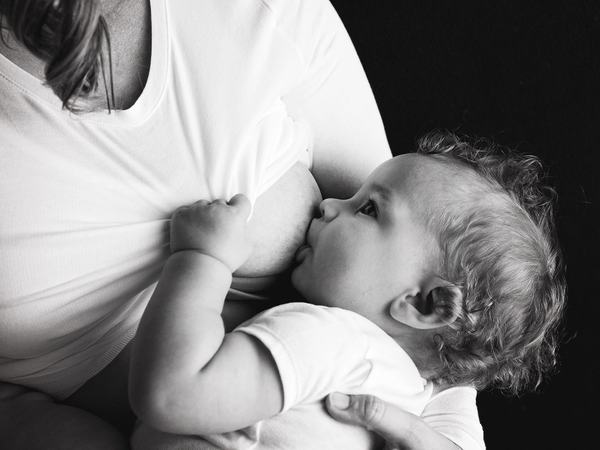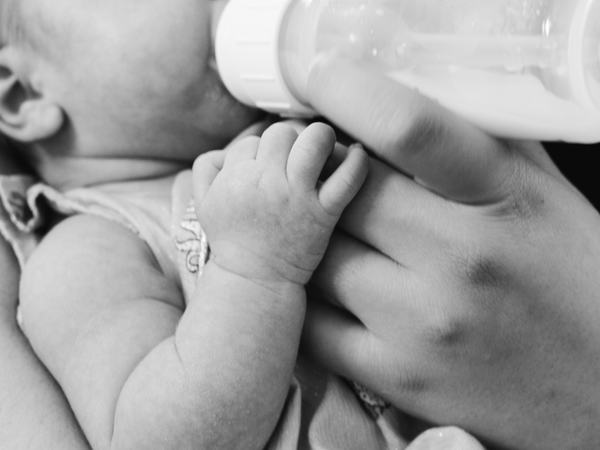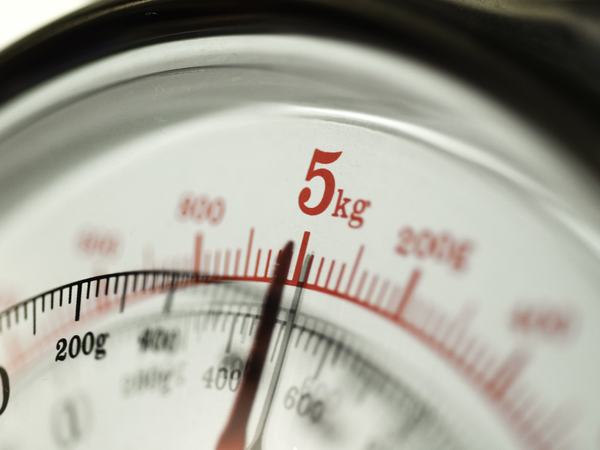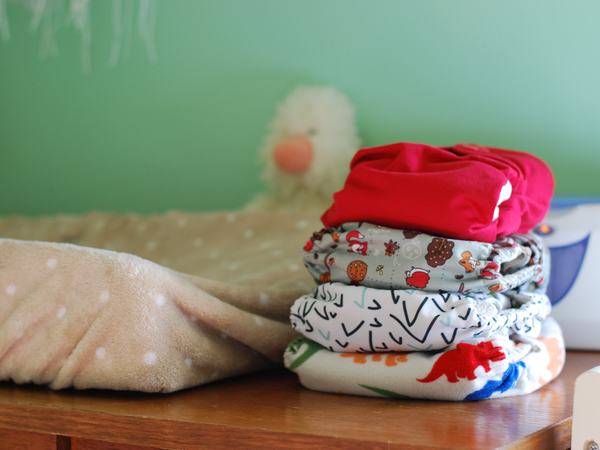7 signs you can tell your baby is breastfeeding effectively
Sometimes moms come to me for breastfeeding advice and ask me whether they have enough milk or whether they don't need to supplement their feedings. The backgrounds that lead to these conclusions are varied: the breast is softer after a few weeks than at the beginning of the breastfeeding period, the baby is restless in the evening, the baby feels like he wants to go to the breast all the time, ...

After I have discussed various aspects of the history and background with the mother, the discussion finally turns to how effective breastfeeding can be recognized. In other words, how you as a mother can tell that your baby is getting enough milk. If you are still unsure, it makes sense to talk about your thoughts with your midwife or a lactation consultant so that you can take a closer look at your situation.
Summary
1. audible swallowing sounds
Effective breastfeeding is characterized by adequate milk transfer. If your baby receives milk while breastfeeding and empties the breast well, you can clearly hear him swallow. The volume of the swallowing sounds depends on the milk flow, the drinking speed and your baby.
Get fit for your breastfeeding start in my online course
Learn many important basics about breastfeeding in my online course Still Basics.
In the first few days, when you are still producing the newborn milk (colostrum), the amounts of milk are still so small that you may not be able to hear the swallowing. This is when it is important to look at other factors for effective breastfeeding. In general, the amount of milk should increase noticeably after three to five days at the latest, so that you can then hear the swallowing sounds better.
At the beginning of the breastfeeding session, you will probably not hear swallowing sounds either. Your baby will first trigger the milk-giving reflex with a very fast sucking pattern. Before that, however, not much milk flows. Once the milk-giving reflex is triggered, your baby will get a lot more milk and you should now be able to hear the swallowing.

Many moms feel the milk-giving reflex clearly and describe the feeling as a tightening sensation or tingling in the nipples. However, not all moms feel the milk-giving reflex. So you don't have to worry if you don't feel it. In the course of a breastfeeding session, the milk-giving reflex is triggered at least three times. However, many women only notice the first reflex.
After the milk-giving reflex has been triggered, you should also hear your baby swallow after about three sucks. The baby first collects a little milk in her mouth and eventually swallows it. If the swallowing is much less frequent or not at all, it is possible that the swallowing is simply so quiet that you do not hear it. However, if it really is barely swallowing milk or not swallowing at all, it is not sucking effectively.
Babies, by the way, after a few weeks, can adjust their sucking to either receive milk, thus satisfying hunger and thirst, or satisfy the need for closeness or sucking without receiving milk.
2. no clicking, clicking or smacking noises.
When your baby makes sounds like smacking at the breast, it sounds very cute and sweet at first. However, smacking, clicking or snapping can also be an indication of an ineffective sucking pattern.
When clicking, your baby briefly slips off the breast, loses suction, and can't hold the vacuum he needs to nurse. Most babies reattach to the breast very quickly after this.
If your baby repeatedly loses suction, breastfeeding can be very exhausting, so that he is exhausted sooner without having been able to satisfy his hunger completely. In addition, your baby swallows more air during this process, which can lead to bloating and tummy ache as a result.
There are many causes for snapping, clicking or smacking. Most often, it is simply due to errors in the attachment process. For example, if your baby is not held well, the mouth is not open enough and your baby is too far away from you, he or she slips off much more easily and has to find the way back to the breast. You can find tips on how to breastfeed well in my article What you should pay attention to when breastfeeding your baby.
Other causes of noises when breastfeeding, independent of swallowing, are oral restrictions, which include a short lingual frenulum, as well as a very strong milk-giving reflex. You can find some information about the tongue tie in my article The (Too) Short Tongue Tie.
As long as the clicking or smacking occurs only sometimes and for a short time and you don't feel any pain, there is not necessarily any need for action. However, if it happens frequently, you should take a look at what is causing it.
3. no pain during breastfeeding
Pain should not occur at any time during breastfeeding. It is always an indication that something is not going right. However, it is important to remember that breastfeeding can be very unfamiliar, especially in the first few days and with your first child, because there has probably never been such a strong suction on your breasts before. Nevertheless, it should not hurt significantly that you have to clench your teeth while breastfeeding or are even afraid of the next breastfeeding meal.

If this is the case, you can take a closer look at where the pain is coming from. If you don't know what the cause might be, you can seek help from your midwife or a lactation consultant.
A common cause of breastfeeding pain is that your nipple rubs against your baby's hard palate or is squeezed. This can cause easily sore nipples and/or a noticeably deformed nipple after breastfeeding. You can read more about this topic in my article Sore nipples - What are the causes and what can I do?
This is caused, for example, when your baby's mouth is not open wide enough during breastfeeding and therefore does not take enough breast tissue into the mouth. You can read more about this in my article What you should pay attention to when breastfeeding your baby, which provides basic information about the correct breastfeeding technique.
If the nipple is pressed and squeezed against the baby's hard palate, this impedes the flow of milk. At the same time, this does not stimulate milk production to the same extent as would be the case with a wide mouth opening and with a lot of breast tissue in the mouth.
In addition, pain causes you to be tense both internally and physically. This tension can delay the milk let-down reflex and stress can inhibit milk production.
As you can see, there are a number of factors that are connected to each other and it is difficult to single out one single factor.
Pain can also come from sore nipples, milk retention, mastitis or other causes. However, the reason is not necessarily ineffective sucking.
4. softer breast after breastfeeding
Milk changes during breastfeeding, both in composition and quantity. In the first days after birth, by the way, even during pregnancy, you produce a special newborn milk. This newborn milk is called colostrum. More about this in my article About the importance of newborn milk (colostrum).
A few days after birth, the amount of milk should become much more and the composition of the milk changes. This is the colloquial milk let-down. Not all women feel it equally strongly and not all even notice it. Often it happens bit by bit and can only be recognized by the change in the milk and the color of the baby's stool.
Now that the amount of milk has increased significantly, you will probably also feel it when your breast is well filled. As you breastfeed your baby, sip by sip, drinking more and more milk, your breast should become increasingly softer. Therefore, after breastfeeding, you should notice that your breasts are softer than before breastfeeding.
If your breasts are constantly tightening and very full, it is best to put your baby on to avoid milk engorgement. Some women experience milk engorgement during lactation. If you need more information about what you can do and where the congestion can come from, you can read my article Milk congestion - What helps and where does it come from?
After a few weeks, when the amount of milk has adjusted to your baby's needs, your breasts will become softer again. The difference will no longer be so noticeable. 5.
5. your baby is relaxed and satisfied after breastfeeding
Babies, just like us adults, are very different in their minds and personalities. Therefore, there are babies who drink very quickly and effectively, and there are babies who take their time and enjoy themselves. Both types can nevertheless get enough milk to the same extent and gain weight well. Therefore, the duration of a breastfeeding meal, for example, is also only a very limited criterion for effective breastfeeding.
On the other hand, there are babies who fall asleep after only a short time at the breast, but have hardly drunk any milk. Or there are babies who are at the breast for what feels like hours, and yet do not feed sufficiently increasingly because they do not manage to empty the breast sufficiently.
In general, babies should be much more relaxed and satisfied after breastfeeding. If the little hands were still clenched into a fist when they were hungry, they should now be open and relaxed.

Nevertheless, there are babies who are not satisfied after breastfeeding. They are busy eliminating (sucking triggers an elimination reflex, so many babies eliminate while breastfeeding or soon after) or have air in their bellies that wants to go up. If your baby is very restless after each breastfeeding, it is a good idea to take a closer look to see if there is a cause for this. This is best discussed with your midwife or a lactation consultant.

If your baby is restless only after a few feedings, there is probably some other cause, such as what I mentioned above. Often babies are also more restless in the evening hours and feel like they are at the breast all the time. This is the so-called cluster feeding, which is perfectly normal and reasonable in phases.
6. good weight gain
The best-known sign of effective breastfeeding and adequate milk production is probably good weight gain. This means that your baby will lose a maximum of 10% of its birth weight after birth and will gain weight again after three days at the latest. After two weeks at the latest, he should have regained his birth weight.
However, fluid administration during birth must also be taken into account. So if you have received a lot of fluid via infusions during birth, some of this fluid will pass to your baby and thus distort the actual birth weight. This sometimes leads to stress and premature supplemental feeding. If you are unsure about this, it is best to ask your midwife, a lactation consultant or a pediatrician for help.

After the first weight loss, the weight development should be along the original weight curve. You can find this curve in your baby's yellow U-booklet. However, since this goes for the first two years, it is hard to see a change in a short period of time. To look at such small time intervals, you can use the Child Growth Tracker app from the WHO (World Health Organization), for example. There you can enter all values and see directly the weight curve of your child.
By the way, in most cases it makes little sense to do a so-called weighing test. This involves weighing the baby before and after breastfeeding to get an idea of how much the baby drank while breastfeeding. This method usually causes more stress than it has any benefit. The amount of milk taken in varies greatly and depends on a wide variety of factors.
Your midwife will weigh your baby as often as necessary or can give you information on this.

A very rough guide is provided by tables of average weight gain. These are based on the age of the baby. The older your baby gets, the smaller the weekly gain will be. However, it is important to look at the overall trend, also in relation to birth weight. A large, heavy baby will not stay on his weight curve if he is just gaining the minimum amount. Also, it is sometimes treacherous to judge gain only from one value to the next. It is actually better to look at the entire progression.
The following table shows a normal weight gain per week (from Intuitive Breastfeeding by Regine Gresens, p.92).
- 1-2 months: 170-330 g
- 3-4 months: 110-330 g
- 5-6 months: 70-140 g
- 7-12 months: 40-110 g
As already written, however, it is better to look at the overall course of weight development.
7. sufficient excretions
If your midwife no longer comes regularly to weigh your baby, it may be unfamiliar to you and you may lack orientation. In addition to weight development, another indication of effective breastfeeding and sufficient milk is if your baby pees sufficiently and has regular bowel movements. The color and consistency are also informative, along with the quantity.

Your baby should have at least five, rather more, full and wet diapers after seven days. In the first days after birth, your infant needs very little milk and therefore pees less. As soon as your milk production increases significantly, your baby should also pee increasingly more. With cloth diapers, by the way, there should be at least six wet diapers. If there are fewer wet diapers or your baby suddenly pees significantly less, you should take a closer look at breastfeeding.
After the meconium, or baby's saliva, has been passed, your baby's stool will become progressively lighter in color. Many describe the color as mustard-colored. It should be creamy to almost runny. During the first six weeks, your baby should have bowel movements about three to five times a day. The amount is then rather small.
After that, the frequency varies greatly among exclusively breastfed babies, ranging from several times a day to once every 14 days. However, as long as your baby does not have severe pain or an extremely distended abdomen, there is no need for action here. This is true as long as the stool consistency remains liquid to mushy and the urine is clear. If you are unsure, you can always ask your midwife or pediatrician for advice.
Sometimes stools are greenish or foamy in exclusively breastfed babies. Most likely, your baby is only drinking at the breast for a relatively short time and is not getting much high-fat milk. However, green stools can also be related to your food. Also, green coloration occurs with some infant formulas. In many cases, the stool color already changes when you (again) breastfeed extensively, i.e. the breastfeeding meals are not limited.
Conclusion
As I have described to you in this article, you can tell by some fACTors that your baby is drinking effectively and getting enough milk. The weight development, which is so often described, is only one criterion.
You can recognize many other aspects directly during breastfeeding or in everyday life with your baby.
If you are unsure at any point whether your baby is really drinking effectively and whether you are producing enough milk, simply ask your midwife or a lactation consultant for an assessment of the situation. You should be able to get competent help here.
Image sources
- Cover image: pixabay.com
- Image 1: pixabay.com
- Image 2: pixabay .com
- Image 3: pixabay .com
- Image 4: pixabay .com
- Image 5: pixabay .com
- Image 6: pixabay .com
- Image 7: pixabay .com
- Image 8: pixabay.com
No comments yet.